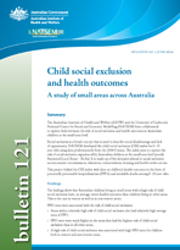Summary
The Australian Institute of Health and Welfare (AIHW) and the University of Canberra's National Centre for Social and Economic Modelling (NATSEM) have collaborated to explore links between the risk of social exclusion and health outcomes in Australian children at the small-area level.
Social exclusion is a broad concept that is used to describe social disadvantage and lack of opportunity. NATSEM developed the child social exclusion (CSE) index for 0-15 year olds using data predominantly from the 2006 Census. The index aims to capture the risk of social exclusion experienced by Australian children at the small-area level (mostly Statistical Local Areas-SLAs). It is made up of five domains related to social exclusion: socioeconomic circumstances, education, connectedness, housing and health service access.
This project linked the CSE index with data on children's health outcomes in the form of potentially preventable hospitalisations (PPHs) and avoidable deaths among 0-14 year olds.



